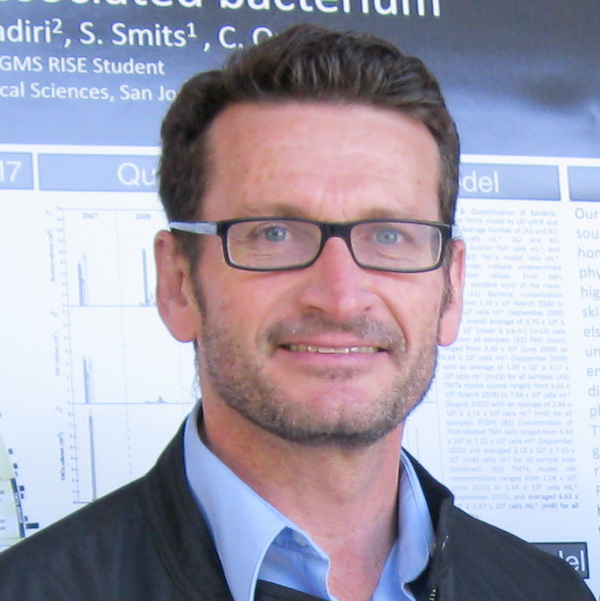Cleber Ouverney
 408-924-4806
408-924-4806
cleber.ouverney@sjsu.edu
ISB 554
Ouverney Lab
For Office Hours, please check the bottom of this Academic Advising page.
If you need academic advising, please email me your updated 4-year plan.
Biology Seminar Series Spring 2025 (schedule TBD)
Education
- Post-doct, 2005 - Stanford University School of Medicine
and The Forsyth Institute - Ph.D., 1999 - University of Southern California
- M.S., 1993 - California State University, East Bay
- B.S., 1990 - Occidental College
Research Interests
The Ouverney lab attempts to characterize the diversity of bacteria in natural microbial communities by type and function. Over 99% of microbes are believed to be uncultivable, hence we rely primarily on culture-independent molecular methods to gather information on the composition and the role of mixed microbial communities. Some uncultivable bacteria found in environmental samples have genetic counterparts in humans, and some of those bacteria have been recently associated with human diseases. Our research aims to discover the natural source of human-associated uncultivable bacteria and to better understand the function of those bacteria play in their respective communities. To identify the bacteria, we rely on DNA sequencing, incluing Next Generation Sequencing platforms. And to study function of microbes, we combine in situ hybridization with micro-autoradiography (STARFISH) to measure the types of nutrients a bacterium uses for growth. By knowing what a bacterium requires to grow can be applied in medicine to curtail the growth of potential pathogens.
Publications
- Cockerham, S, B Lee, RA Orben, RM Suryan, LG Torres, P Warzybok, R Bradley, J Jahncke, HS Young, C Ouverney, S. Shaffer. 2019. Microbial ecology of western gull (Larus occidentalis). J. Microbial Ecology. v78 p. 665-676.
- Ouverney, C. 2016. Assessment of prokaryotic biological activity at the single cell level by combining microautoradiography and fluorescence in situ hybridization (FISH). In Yates M, Nakatsu C, Mille R, Pillai S (ed), Manual of Environmental Microbiology, Fourth Edition. ASM Press, Washington, DC, pp 2.2.2-1-2.2.2 (Book Chapter, American Society for Microbiology).
- Caldwell, A.C., L.C. Fidéles Silva, C.C. da Silva, and C.C. Ouverney. 2015. Prokaryotic Diversity in the Rhizosphere of Organic, Intensive, and Transitional Coffee Farms in Brazil. PLoSONE 10(6): e0106355. doi: 10.1371/journal.pone.0106355
- Dinis JM, DE Barton, J Ghadiri, D Surendar, K Reddy, F Velasquez, CL Chaffee, MC Lee, H Gavrilova, H Ozuna, SA Smits, and CC Ouverney. 2011. In Search of an Uncultured Human- Associated TM7 Bacterium in the Environment. PLoS ONE 6(6): e21280. doi:10.1371/journal.pone.0021280
- Smits SA and CC Ouverney. 2010. Phylometrics: a pipeline for inferring phylogenetic trees from a sequence relationship network perspective. BMC Bioinformatics, 11(Suppl 6):S18. doi:10.1186/1471-2105-11-S6-S18.
- Smits SA and CC Ouverney. 2010. jsPhyloSVG: A Javascript Library for Visualizing Interactive and Vector-Based Phylogenetic Trees on the Web. PLoS ONE 5(8): e12267. doi: 10.1371/journal.pone.0012267
- Marcy, Y, C Ouverney. EM Bik, T Lösekann, N Ivanova, HG Martin, E Szeto, D Platt, P Hugenholtz, DA Relman, SR Quake. 2007. Dissecting biological “dark matter” with single-cell genetic analysis of rare uncultivated TM7 microbes from the human mouth. PNAS 104(29): 11889-94.
- Jones, BW, A Maruyama, CC Ouverney, and MK Nishiguchi. 2007. Spatial and Temporal Distribution of the Vibrionaceae in Coastal Waters of Hawaii, Australia and France. Microbial Ecology, 54: pp
- Ouverney, CC, GC Armitage, and DA Relman. 2004. Use of Cloned Artificial Targets for FISH (catFISH) for the optimization of oligonucleotide probe hybridization conditions with 16S rRNA clones for in situ quantification of uncultivated prokayotic cells. In G. A. Kowalchuk, F. J. de Bruijn, I. M. Head, A. D. L Akkermans, and J. D. van Elsas, editors. Molecular Microbial Ecology Manual, 2nd edition. Chapter 3.12: 727-742-169. Kluwer Academic Publishers, Dordrecht.
- Ouverney CC and JA Fuhrman. 2004. Correlating single-cell count with function in mixed natural microbial communities through STARFISH. In G. A. Kowalchuk, F. J. de Bruijn, I. M. Head, A. D. L. Akkermans, and J. D. van Elsas, editors. Molecular Microbial Ecology Manual, 2nd edition. Chapter 8.08: 1689-1710. Kluwer Academic Publishers, Dordrecht
- Lepp, PW, MM Brinig, CC Ouverney, K Palm, GC Armitage, and DA Relman. 2004. Methanogenic Archaea and human periodontal disease. PNAS, 101(16): 6176-6181.
- Ouverney, C. C., G. C. Armitage, and D. A. Relman. 2003. Single-cell enumeration of an uncultivated TM7 subgroup in the human subgingival crevice. Applied and Environmental Microbiology, 69 (10): 6294-6298.
- Maywald, M, A Herbay, DN Fredricks, CC Ouverney, JC Kosek, and, DA Relman. 2003. Cultivation of Tropheryma whipplei from Cerebrospinal Fluid. J. of Infectious Disease, 188: 801-888.
- Brinig, MM, PW Lepp, CC Ouverney, GC Armitage and DA Relman. 2003. Prevalence of Bacteria of Division TM7 in human subgingival plaque and their association with disease. Applied and Environmental Microbiology, 69(3):1687-1694
- Ouverney, CC and JA Fuhrman. 2000. Marine planktonic Archaea take up amino acids. Applied and Environmental Microbiology, 66 (11): 4829-4833
- Ouverney, CC and JA Fuhrman. 1999. Combined microautoradiography-16S rRNA probe technique for the determination of radioisotope uptake by specific microbial cell types in situ. Applied and Environmental Microbiology. 65 (4):1746-1752.
- Ouverney CC. 1999. Dissecting the Marine bacterioplankton "black box" by type and function through FISH and STARFISH, Ph.D. Dissertation, University of Southern California.
- Fuhrman, JA and CC Ouverney. 1998. Marine microbial diversity studied via 16S rRNA sequences: coastal cloning results and counting of native archaea with fluorescent single cell probes. Aquatic Ecology. 32: 3-5
- Ouverney, CC and JA Fuhrman. 1997. Increase in fluorescence intensity of 16S rRNA in situ hybridization in natural samples treated with chloramphenicol. Applied and Environmental Microbiology, 63(7): 2735-2740.